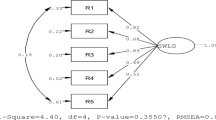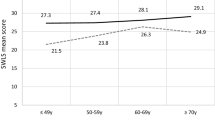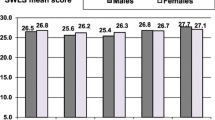Abstract
In a previous study, the Life Satisfaction Questionnaire (LSQ) was developed especially for women with breast cancer. The aim of the present study was to assess the psychometric properties of the LSQ in a randomized sample of Swedish women and to compare the perceived quality of life with that of women suffering from breast cancer. Another aim was to relate the result to educational background. A total of 257 women aged 20–80, randomly selected from the Swedish population register, answered the LSQ. The result was compared with that from 362 women aged 27–78 suffering from breast cancer. The construct validity was calculated by a principal component analysis, and the reliability by Cronbach α-coefficients. It was concluded that the LSQ has acceptable validity and reliability. The result also showed that the women with breast cancer rated their perceived quality of life higher than women in general with respect to the quality of personal relations and the quality of daily activities, but lower for physical symptoms. In the comparison with respect to educational background, women with university education rated their quality of life higher than women with other types of education. The testing of the LSQ will continue.
Similar content being viewed by others
References
Anderson RT, Aaronson NK, Wilkin D. Critical re-view of the international assessments of health-related quality of life. Qual Life Res 1993; 2: 369±395.
Wiklund I, Romanus B, Hunt SM. Self-assessed disability in patients with arthrosis of the hip joint. Reliability of the Swedish version of the Nottingham Health Pro®le. Int Disabil Stud 1987; 10(4): 159±163.
Bergner M, Bobbitt RA, Cartner WB, Gibson BS. The Sickness Impact Pro®le: Development and ®nal revi-sion of a health status measure. Med Care 1981; 19(8):787±805.
Brorson B, Ifver J, Hays RD. The Swedish health-re-lated quality of life survey (SWED-QUAL). Qual of Life Re 1993; 2: 33±45.
Ware Jr JE. SF-36: Manual and Interpretation Guide. Boston: Health Institute, New England Medical Cen-ter, 1993.
Sullivan M, Karlsson J, Ware Jr JE. The Swedish SF-36 Health Survey ± I. Evaluation of data quality, scaling assumptions, reliability and construct validity across general populations in Sweden. Soc Sci Med 1995; 41(10): 1349±1358.
Ferrans CE, Powers MJ. Psychometric assessment of the Quality of Life Index. Research in Nursing and Health, 1992; 15: 29±38.
Spitzer WO, Dobson AJ, Hall J et al. Measuring the quality of life of cancer patients. J Chron Dis 1981; 34: 585±597.
Schipper H, Clinch J, McMurray A, Levitt M. Mea-suring the quality of life of cancer patients: The func-tional living index ± Cancer: Development and validation. J Clin Oncol 1984; 2(5): 472±483.
Cosgarelli-Schag CA, Heinrich RL. Development of a comprehensive quality of life measurement tool: CARES. Oncology 1990; 4: 135±138.
Cosgarelli-Schag CA, Heinrich RL, Ganz PA. Cancer inventory of problem situations: An instrument for assessing cancer patients' rehabilitation needs. J Psy-chosoc Oncol 1983; 14: 11.24.
Cella DF, Tulsky DS, Gray G et al. The Functional Assessment of Cancer Therapy Scale: Development and validation of the general measure. J Clin Onc 1993; 3: 570±579.
Aaronson NK, Ahmedzai S, Bullinger M et al. for the EORTC Study Group on Quality of Life. The Euro-pean Organization for Research and Treatment of Cancer QLQ-C30: A Quality-of-life instrument for use in international clinical trials in oncology. J Nat Cancer Inst 1993; 85(5): 365±375
Carlsson M, Hamrin E. Psychological and psychosocial aspects of breast cancer and breast cancer treatment. Cancer Nursing 1994; 17(5): 418±428.
Carlsson M, Hamrin E. Measurement of quality of life in women with breast cancer. Development of a Life Satisfaction Questionnaire (LSQ-32) and a comparison with the EORTC QLQ-C30. Quality of Life Research 1996; 5: 265±274
Gorsuch R. Factor Analysis. New Jersey: Lawrence Erlbaum Associates, 1983.
Omne-Ponte n M, Holmberg L, Burns T, Adami HO, BergstroÈ m R. Determinants of the psychosocial out-come after operation for breast cancer. Results of a prospective comparative interview study following mastectomy and breast conservation. Eur J Cancer 1992; 28A: 1062±1067.
Irvine D, Brown B, Crooks D, Roberts J, Browne G. Psychological adjustment in women with breast cancer. Cancer 1991; 67: 1097±1117.
Neuling SJ, Winefelt HR. Social support and recovery after surgery for breast cancer: frequency and correlates of supportive behaviours by family, friends, and sur-geon. Soc Sci Med 1988; 27: 385±392.
Waxler-Morrison N, Hislop TG, Mears B, Kan L. E.ects of social relationship on survival for women with breast cancer: a prospective study. Soc Sci Med 1991; 33: 177±183.
LaFortune Fredette S. Breast cancer survivors: con-cerns and coping. Cancer Nursing 1995; 18(1): 35±46.
Hilton A. Getting back to normal: The family experi-ence during early stage breast cancer. Oncol Nurs Fo-rum, 1996; 4: 605±614.
Collins RL, Taylor SE, Skokan LA. A better world or a shattered vision? Changes in life perspectives fol-lowing victimization. Social Cognition 1990; 8(3): 263±285.
Moch SD. Health within the experience of breast can-cer. J Adv Nurs 1990; 15: 1426±1435.
O'Connor AP, Wicker CA, Germino BB. Under-standing the cancer patient's search for meaning. Cancer Nursing 1990; 13(3): 167±175.
Mackenbach JP, Kunst AE, Cavelaars AE, Groenhof F, Geurts JJ, and the EU Working Group on Socio-economic inequalities in Health. Socioeconomic in-equalities in morbidity and mortality in western Europe. Lancet 1997; 349: 1655±1659. 27. Likert R. A technique for the measurement of atti-tudes. New York: Archives of Psychology, No 140, 1932.
Statistics Sweden, 1997. Offcial Swedish Statistics.
Cronbach LJ. Coeffcient alpha and the internal struc-ture of test, Psychometrika 1951; 16: 297±334.
Haycock K, Roth J, Gagnon J, Finzer W, Soper C, Sager S, Rocco T, Bauer L. StatView the ultimate in-tegrated data analysis & presentation system. ABA-CUS Concepts, Inc, Berkeley, CA. 1992.
Author information
Authors and Affiliations
Rights and permissions
About this article
Cite this article
Carlsson, M., Hamrin, E. & Lindqvist, R. Psychometric assessment of the Life Satisfaction Questionnaire (LSQ) and a comparison of a randomised sample of Swedish women and those suffering from breast cancer. Qual Life Res 8, 245–253 (1999). https://doi.org/10.1023/A:1008875306645
Issue Date:
DOI: https://doi.org/10.1023/A:1008875306645




